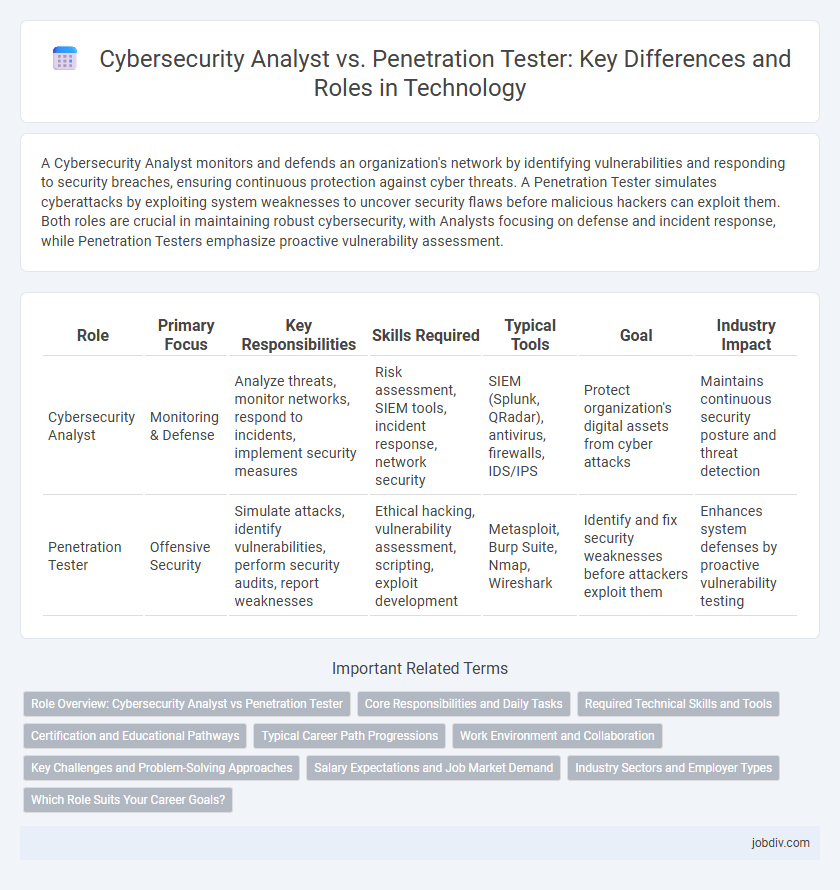A Cybersecurity Analyst monitors and defends an organization's network by identifying vulnerabilities and responding to security breaches, ensuring continuous protection against cyber threats. A Penetration Tester simulates cyberattacks by exploiting system weaknesses to uncover security flaws before malicious hackers can exploit them. Both roles are crucial in maintaining robust cybersecurity, with Analysts focusing on defense and incident response, while Penetration Testers emphasize proactive vulnerability assessment.
Table of Comparison
| Role | Primary Focus | Key Responsibilities | Skills Required | Typical Tools | Goal | Industry Impact |
|---|---|---|---|---|---|---|
| Cybersecurity Analyst | Monitoring & Defense | Analyze threats, monitor networks, respond to incidents, implement security measures | Risk assessment, SIEM tools, incident response, network security | SIEM (Splunk, QRadar), antivirus, firewalls, IDS/IPS | Protect organization's digital assets from cyber attacks | Maintains continuous security posture and threat detection |
| Penetration Tester | Offensive Security | Simulate attacks, identify vulnerabilities, perform security audits, report weaknesses | Ethical hacking, vulnerability assessment, scripting, exploit development | Metasploit, Burp Suite, Nmap, Wireshark | Identify and fix security weaknesses before attackers exploit them | Enhances system defenses by proactive vulnerability testing |
Role Overview: Cybersecurity Analyst vs Penetration Tester
Cybersecurity Analysts monitor and protect organizational networks by identifying vulnerabilities, analyzing security incidents, and implementing defensive measures to prevent cyber attacks. Penetration Testers simulate real-world cyber attacks to exploit security weaknesses, providing detailed reports to help organizations strengthen their defenses. Both roles are crucial in maintaining robust cybersecurity frameworks, with analysts focusing on continuous monitoring and testers emphasizing proactive threat identification.
Core Responsibilities and Daily Tasks
Cybersecurity analysts monitor networks for security breaches and investigate incidents, ensuring the implementation of security protocols and risk assessments to protect organizational data. Penetration testers simulate cyberattacks to identify vulnerabilities in systems, performing controlled exploits and reporting findings to strengthen defenses. Both roles require expertise in threat detection, vulnerability analysis, and compliance with security policies but differ fundamentally in their proactive versus reactive responsibilities.
Required Technical Skills and Tools
Cybersecurity Analysts require proficiency in network security, incident response, and risk assessment tools such as SIEM platforms, firewalls, and antivirus software to monitor and protect systems. Penetration Testers must possess advanced skills in ethical hacking, vulnerability assessment, and exploitation techniques using tools like Metasploit, Burp Suite, and Nmap to identify and exploit security weaknesses. Both roles demand strong knowledge of operating systems, programming languages, and security protocols, but Penetration Testers emphasize offensive tactics while Cybersecurity Analysts focus on defensive strategies.
Certification and Educational Pathways
Cybersecurity analysts typically pursue certifications such as CompTIA Security+, Certified Information Systems Security Professional (CISSP), and Certified Information Security Manager (CISM), which emphasize risk management, security policies, and incident response. Penetration testers often require more specialized certifications like Offensive Security Certified Professional (OSCP), Certified Ethical Hacker (CEH), and GIAC Penetration Tester (GPEN), focusing on vulnerability assessment, ethical hacking, and exploit techniques. Educational pathways for analysts generally include degrees in cybersecurity, information technology, or computer science, while penetration testers may benefit from advanced technical coursework or bootcamps centered on network security and offensive security skills.
Typical Career Path Progressions
Cybersecurity analysts typically begin their careers in IT support or network administration before advancing to roles focused on threat detection and incident response, eventually moving into senior analyst or security manager positions. Penetration testers often start as security researchers or junior ethical hackers, gaining expertise in vulnerability assessment and exploit development, and progress to senior penetration tester or red team leader roles. Both career paths value certifications like CISSP, CEH, and OSCP, which enhance opportunities for advancement and specialization.
Work Environment and Collaboration
Cybersecurity analysts typically operate within corporate IT departments, collaborating closely with network engineers, system administrators, and incident response teams to monitor and defend against security threats. Penetration testers often work in more project-based settings, partnering with development teams and clients to simulate attacks and identify vulnerabilities in applications and infrastructure. Both roles require strong communication skills to effectively share findings and implement security improvements across organizations.
Key Challenges and Problem-Solving Approaches
Cybersecurity analysts face the challenge of continuously monitoring networks to detect and respond to emerging threats using advanced threat intelligence and incident response frameworks. Penetration testers focus on identifying system vulnerabilities by simulating real-world attacks, requiring deep expertise in exploit development and ethical hacking techniques. Both roles demand strong problem-solving skills, with analysts prioritizing rapid threat mitigation and testers emphasizing proactive vulnerability assessment to enhance organizational security posture.
Salary Expectations and Job Market Demand
Cybersecurity analysts typically earn between $70,000 and $110,000 annually, reflecting steady demand due to increasing corporate reliance on threat detection and risk management. Penetration testers command higher salaries, often ranging from $80,000 to $130,000, driven by critical expertise in vulnerability assessment and ethical hacking. The job market for both roles is expanding rapidly, but penetration testers face higher competition due to specialized skill requirements, while cybersecurity analysts benefit from broader opportunities across industries.
Industry Sectors and Employer Types
Cybersecurity analysts are primarily employed across a broad range of industry sectors including finance, healthcare, government, and retail, focusing on protecting organizational networks and systems from cyber threats. Penetration testers commonly work in specialized technology firms, cybersecurity consultancies, and sectors with demanding security requirements such as defense, banking, and large enterprises, conducting simulated attacks to identify vulnerabilities. Both roles are crucial in industries with rigorous data protection regulations, relying heavily on expertise to secure sensitive information and maintain compliance.
Which Role Suits Your Career Goals?
Cybersecurity Analysts focus on monitoring and defending networks against threats, using tools like SIEM systems to detect vulnerabilities and respond to incidents. Penetration Testers simulate attacks to identify security weaknesses by exploiting vulnerabilities, providing actionable insights for strengthening defenses. Choose a role based on your interest in proactive defense and real-time threat analysis versus offensive security and ethical hacking methodologies.
Cybersecurity Analyst vs Penetration Tester Infographic

 jobdiv.com
jobdiv.com